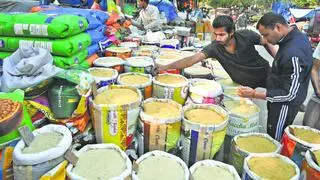India’s goods exports contracted for the first time this fiscal, falling 16.6 per cent in October 2022 to $29.78 billion (year-on-year), with shipments of most major items, such as petroleum, gems and jewellery, engineering goods, chemicals, textiles, and pharmaceuticals, taking a hit.
Imports increased 5.7 per cent to $ 56.69 billion in October 2022, propelled by a sharp rise in petroleum and fertiliser imports, resulting in a 50 per cent rise in the trade deficit to $26.91 billion per quick estimates released by the commerce and industry ministry for october on Tuesday
Weakening demand
While weakening global demand for goods due to high inventory, rising inflation, currency volatility, and the continued war in Ukraine is a major reason behind the lacklustre export performance, Commerce Secretary Sunil Barthwal said that Dussehra and Diwali celebrations during October this year may have also contributed as workers went on leave for the festivities. In 2021, Diwali was celebrated in November.
“This may be a seasonal blip. We will assess whether this is a trend that will persist after looking at how November trade numbers turn out,” Commerce Secretary Sunil Bharthwal said at a press briefing on Tuesday.
Bharthwal pointed out that the WTO had reduced global trade growth forecasts to 1 per cent in 2023 and the IMF had downgraded GDP growth projections, and these needed to be watched.
However, there were regions that were expected to perform better than others, such as North America, the Middle East, Latin America, and parts of Africa, where the exporters’ focus must be, Barthwal added.
Goods export
Goods export in April–October 2022 increased 12.55 per cent to $ 263.35 billion. Most of the growth happened in the first quarter of the fiscal year, as since July, export growth has started slowing down. Goods imports during the seven-month period rose 33.12 per cent to $436.81 billion. The trade deficit in April–October 2022 nearly doubled to $173.46 billion against $94.16 billion in the same period last year.
Exporters’ body FIEO suggested that in the current situation, the focus should be on providing liquidity at a competitive cost to the export sector, and therefore, RBI may consider opening an export credit refinance facility to banks. This would encourage banks to lend to the export sector with refinancing from the RBI at the repo rate, FIEO pointed out in a statement.
“Since the interest rates have moved upward and are now higher than the pre-covid level, there is a strong case to restore the interest equalisation support to 5 per cent and 3 per cent respectively, as existed prior to the covid period,” it said.
In 2021–22, Indian exports touched an all-time high of $421 billion, growing over 40 per cent, but because of the global uncertainty, the Commerce Ministry is yet to share a target for the current fiscal year. Officials had said earlier that the possibility of attaining exports worth $450-460 billion was being looked at.
“The export slowdown has been caused by both supply and demand-side factors. Continued bottlenecks in logistics and supply chain, shortages of semiconductors and some metal commodities, and elevated energy prices keep pressure on the production cycle, on the supply side…The inflationary pressures due to energy prices has reduced the purchasing power of households, on the demand side,” pointed out Prahalathan Iyer, Chief General Manager, Research and Analysis, India Exim Bank.








Comments
Comments have to be in English, and in full sentences. They cannot be abusive or personal. Please abide by our community guidelines for posting your comments.
We have migrated to a new commenting platform. If you are already a registered user of TheHindu Businessline and logged in, you may continue to engage with our articles. If you do not have an account please register and login to post comments. Users can access their older comments by logging into their accounts on Vuukle.